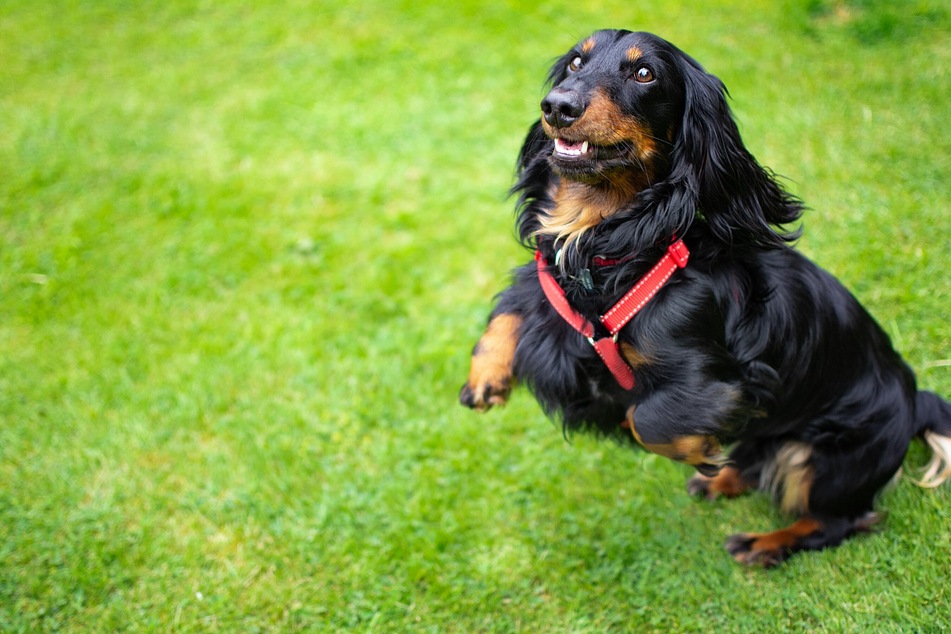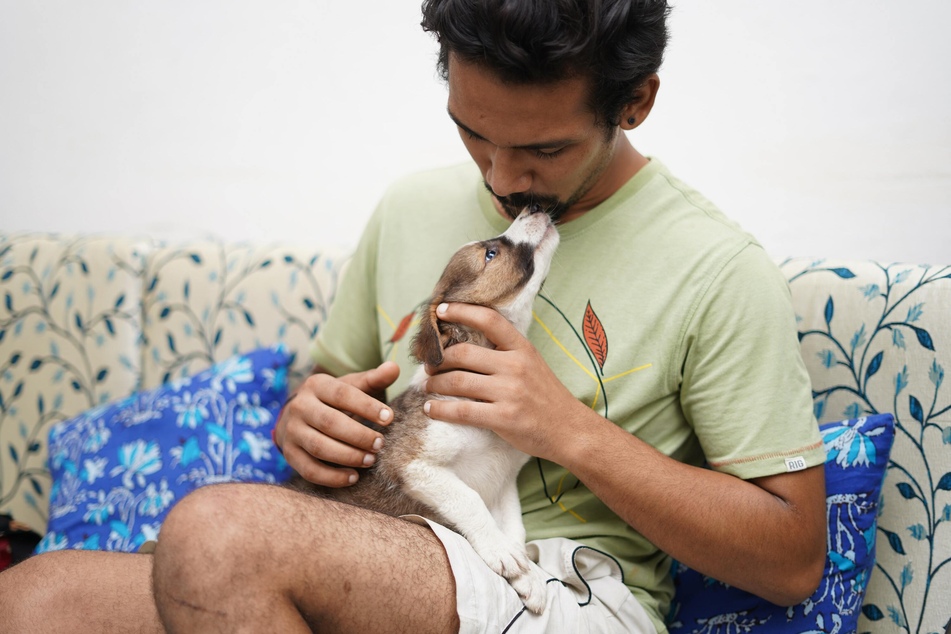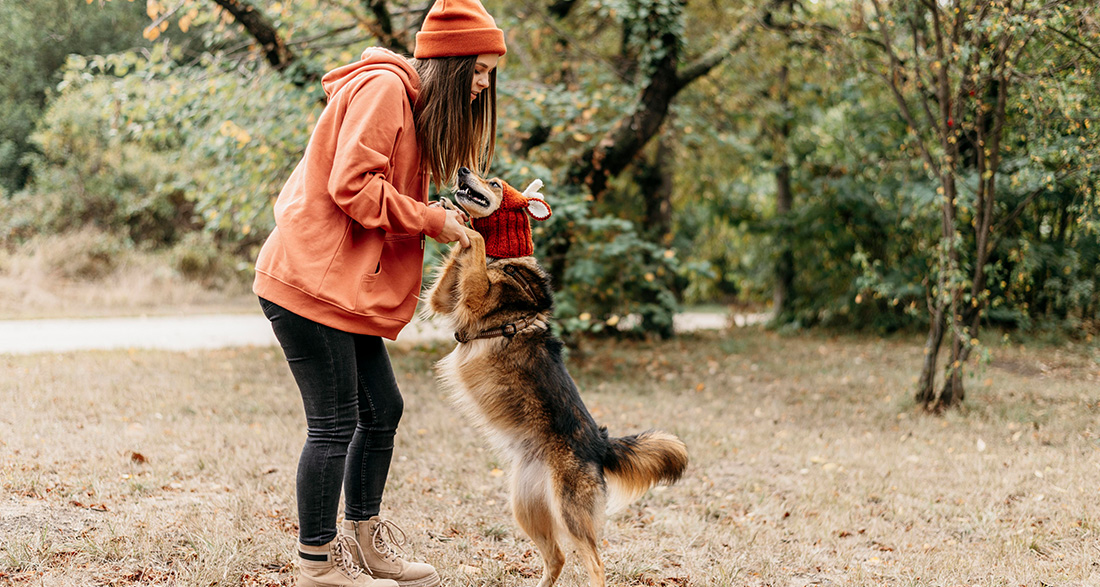When strangers, visitors, or even owners are jumped on by dogs, it not only indicates a lack of training but can also be very painful, depending on the size of the dog. How can you teach your dog to stop jumping? The answer is in the dog guide.
In many places, you encounter dog owners walking their four-legged friends. It’s not uncommon for a dog to approach strangers and sometimes jump on them.
Some people, due to terrible news about dog attacks or bad experiences, fear unfamiliar dogs. When a dog jumps on them, they go into panic mode.
However, dogs don’t always have malicious intent. Often, they’ve developed this behavior in childhood, are excited, or simply enjoy jumping.
Jumping makes dogs less controllable, and they seem very impulse-driven. To make handling the dog more pleasant and ensure the safety of others, teaching dogs not to jump is essential.
With a few tricks, you can quickly train your dog not to jump. Additionally, iHugDogs provides useful tips on how to properly train puppies so that they quickly abandon the instinctive jumping behavior.
Why does your dog jump on others, including you?
When dogs jump on people, it can have the following reasons:
- Greeting
- Testing boundaries
- Excitement (displacement behavior)
- Playfulness
- Stress
- Defense
- Social interaction in the form of licking faces
- Simple joy of jumping
By the way, dogs that jump on someone don’t necessarily have a dominant nature. It depends on the interaction with others. Being dominant describes the dog’s relationship with others. A dog can be dominant towards its owner but submissive towards another family member.
How do you teach your dog not to jump?
Unfortunately, ignoring jumping often doesn’t work with adult dogs. They’ve stored this behavior as praiseworthy and associate it with positive feelings. Moreover, if you push them away with gentle gestures when they jump, they might interpret it as interaction or play, making it enjoyable for them and encouraging repetition.
One option is not to give the dog space. Specifically, this means not stepping back but approaching the dog. You can support this by blocking the dog with your arm or holding both arms outstretched toward the dog, gently but directly. Be cautious not to make the gesture too forceful, as the dog might lightly bump its head against it.
Dog owners can interrupt jumping by using a command like “Sit!” It’s crucial that the dog masters the command well and that the action prevents jumping. If successful, praise the dog calmly to reinforce the behavior.
If treats or snacks are used during dog training, this can also apply to breaking the habit of jumping. One option is to throw the treat on the ground so that the dog doesn’t jump. This approach aims to relax the greeting situation. Simply take food or treats before entering the house. If the dog rushes towards you and prepares to jump, throw the treat away. While the dog releases its initial excitement on the treat, you can calmly arrive and then greet the dog on the ground.
To strengthen the desired behavior, your dog should receive praise, such as treats, your face for greetings, or petting, without jumping.

Optionally, you can associate jumping with a negative experience for the dog. Hold the dog’s paws when it jumps. Either stand still with the dog for a while until you feel it wants to break free and then hold a few seconds longer, or take a few steps with the dog, making it walk backward, which is uncomfortable for it. After a few repetitions, the dog should stop jumping. Be prepared that the dog might try to bite your hands.
Generally, it’s essential to give the dog rest periods throughout the day. If it’s challenged all day, it becomes challenging for it to remain calm and becomes very impulsive. Also, ensure that eye contact with the dog always implies a dialogue. The dog feels constantly stimulated by it and becomes even more excited. If you don’t approve of its behavior, turn your gaze and body away from it.
How can you prevent jumping on visitors and strangers?
If your dog jumps on other people during walks or when visitors arrive, you should train it to stop. Some people may be afraid of dogs or feel bothered.
The initial impulse when encountering a stranger might be to hold the leash tightly, which the dog interprets as a signal for an exciting event. In this case, the stranger becomes even more interesting. Observe if the dog jumps with a tight leash.
In this situation, you might want to let the leash go slack or practice with a long lead. If you don’t react, don’t pay much attention, and remain calm, your dog will lose interest. This also applies to visitors. In this case, staying calm, giving commands, and placing treats on the floor can be helpful.
Unfamiliar people who don’t know the dog often unintentionally encourage the behavior due to ignorance. Consider what or who the dog might encounter outside. High voices, noises, and attempts to pet could be possible reactions from others. Train your dog to remain calm by exposing it to distractions in a protected space. Praise it only when it stays relaxed or doesn’t react to external stimuli. You’ll be surprised how quickly your dog can learn this.

How to prevent jumping in puppies?
Jumping is instinctive in puppies. Dogs lick the faces of other animals as a calming signal, when begging for food, or during similar social interactions. Since people’s heads are higher, puppies need to jump.
Dogs don’t understand that cute puppies are allowed to do things that adult dogs shouldn’t. If owners teach puppies not to jump early on, this behavior won’t occur in adult dogs. When training the puppy to react calmly to high voices, noises, and strangers, you lay the foundation for a relaxed dog.
Always be careful not to reinforce behaviors in puppies that you wouldn’t want in an adult dog.
Contrary to adult animals, ignoring usually suffices for puppies. Even if it’s challenging, turn away and, if necessary, leave the room. Cross your arms so that it can’t reach your hands. Only praise the puppy when all four paws are on the ground. If it demands too much attention, briefly leave the room.
Realize that the puppy is watching you closely and learning from it.
Subsequently, ensure that you don’t unconsciously teach jumping to the puppy. For example, if you play by throwing the ball only when the dog excitedly jumps, it believes that it has to jump for you to throw the ball. Throw the ball only when it calmly waits. By establishing clear rules for the game, you weaken the dog’s impulsive tendencies.
When dog owners and others interact with dogs calmly but firmly, it’s easy to wean them off undesirable behaviors like jumping.


